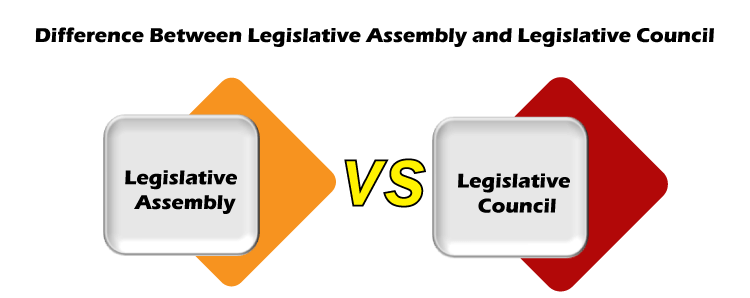Difference between Legislative Assembly and Legislative CouncilWe all have heard terms like the legislative council, legislative assembly, politics, Lok sabha, Rajya sabha, etc., in our civics classes. Social Science is an academic subject that deals with the politics of different nations. There are several political terms that we use during our lectures. Out of these, legislative assembly and legislative council are important terms. We are often confused between both the terms as they both seem to be the same. So, first let's look at some of the key differences.
These are some of the important differences between the legislative council and the legislative assembly. But do we know how the legislative council and the legislative assembly function? No. So, let us further understand what both the terms include and how they function. The Legislative assembly is another name of the legislature that is given in other countries. The legislative assembly represents a political house. Many members of the Commonwealth nations use this term. Apart from the other countries, the term 'legislative assembly' is also used by Indian states, Canada, and Union Territories. The legislative assembly is one of the important terms that is used in several jurisdictions. This assembly is also used to give everyday speeches to address the people. Now, let us look at some of the examples regarding the legislative assemblies in different nations. 
There are two chambers in the Indian parliament, i.e., upper house and lower house. Both the chambers are responsible for carrying out the daily activities in the parliament. So, in India, the lower house acts as the state legislative assembly. The State Legislative Assembly is also called the Vidhan Sabha. The same name is provided to the Union Territories, Delhi, Jammu & Kashmir, etc. The upper house comprising a bicameral legislature (legislature divided into two different assemblies) is called State Legislative Council. The ministers or members under the state legislative assembly are called MLAs. Now, let us take a look at other countries as well. The lower chambers of the Australian States are also called legislative assemblies. In Canada, too, out of ten provinces, seven are termed as the legislative assembly. All the legislative assemblies in Canada are unicameral, i.e., there is only one legislative assembly or chamber in the parliament. Other sovereign countries that practice state legislature are Bolivia, Costa Rica, Samoa, Thailand, Sudan, Puerto Rico, etc. Now, let us discuss some points regarding the members of legislative assemblies.
So, these are some key points regarding the function of a legislative assembly and an MLA. The legislative assembly has the responsibility of making laws, taking judicial decisions, controlling the budget, etc. The legislative assembly makes decisions irrespective of the parliament. We tend to get confused between the legislative assembly and legislative council. We feel that both the terms indicate the same meaning. But it is not so. Now, let us discuss the legislative council in detail. The state legislative council, which is also known as Vidhan Parishad, is the upper house that consists of six states of India. These six states have a bicameral legislature wherein the legislature is divided into two different chambers or houses. We can see the formation of the council in Article 168 of the Constitution of India. According to some reports, only six states in India have a legislative council. Apart from that, the current state to have a legislative council is Telangana. The members of the legislative council are called MLCs. To become an MLC, he/ she must be a citizen of the country and must not have any criminal case registered against them. The member of the legislative council must not be a member of the legislative assembly or parliament. The time of a legislative council is six years. After every two years, some of the members of the legislative council retire. Now, you must be wondering how are MLCs elected and who has the responsibility of electing them. Well, an MLC is elected by a variety of departments. Some of them include:
The people/ bodies mentioned above are responsible for electing an MLC. But it is interesting to note that not much power is given to the legislative council. A legislative council does not have any authority to form or dissolve the state government. The council cannot pass any laws or bills as well. One of the important roles/ benefits of the legislative council is that the council's chairman enjoys the same honor and status as a cabinet minister of the state. It is important to note that the parliament can create or dissolve the legislative council according to Article 169 of the Constitution. Historically, many legislative councils were dissolved by the Parliament of India in the Independence Era. This was done because there was a delay in law-making and passing necessary bills. One more reason for criticizing the legislative council is that they do not practice democracy. MLCs are elected by the registered local and main bodies, which results in a lack of democracy. This is the reason why only six states have a legislative council. The legislative council is a parliamentary working body that does not enjoy much authority in making or passing laws. Both legislative council and legislative assembly are important parts of the parliament. They are the law-making bodies that help in developing a particular state. The key differences between are mentioned above. Thus, both terms are essential for the better functioning of the state.
Next TopicDifference between
|
 For Videos Join Our Youtube Channel: Join Now
For Videos Join Our Youtube Channel: Join Now
Feedback
- Send your Feedback to [email protected]
Help Others, Please Share










